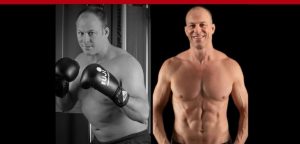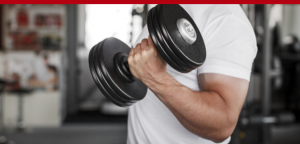by Ted Ryce
470: Everything You Need To Know About Cardiovascular Training with Ted Ryce
by Ted Ryce
by Ted Ryce
470: Everything You Need To Know About Cardiovascular Training with Ted Ryce
470: Everything You Need To Know About Cardiovascular Training with Ted Ryce
more
by Ted Ryce
470: Everything You Need To Know About Cardiovascular Training with Ted Ryce
Cardio exercising is one of the best things you can do for your body and overall health, and if you are over 40 and want to look and feel your best, cardio is a must.
You might have heard that cardiovascular training improves your heart and lung function, lowers your risk of heart disease and diabetes, improves your sleep, strengthens your muscles, and, of course, increases fat loss.
Weight loss happens when you achieve and maintain a calorie deficit. That means you should burn more calories than you consume. And cardio exercises are a great way to do that.
Wondering how often you should train to burn fat? Want to find out how hard and for how long you should do cardio training? Find out the answers to these questions and much more in this new episode!
This episode is a part of the Legendary Program course, which is Ted’s coaching course. We decided to release exclusively for you for a limited time ONLY.
In this episode, Ted will talk about cardio training, the ideal frequency, duration, and intensity. He will also reveal some essential guidelines for cardio training.
Tune in to learn how to structure your sweat sessions in the most effective way to burn off your belly.
You’ll learn:
- Frequency of cardio training: how often?
- Duration of cardio training: how long?
- The intensity of cardio training: how hard?
- Guidelines for cardio training
- How to estimate training intensity with perceived exertion
- Rating of perceived exertion (RPE)
- And much more…
Related Episodes:
469: The Ultimate Secret to Fat Loss with Ted Ryce
451: Concurrent Training: The Ultimate Cardio Strategy
438: The Easiest Cardio Workout You Can Do (That Actually Works) with Ted Ryce
Do You Need Help Creating A Lean Energetic Body And Still Enjoy Life?
We help busy entrepreneurs, executives, and other high-performers burn fat, look and feel younger while enjoying the lifestyle they worked hard to create.
If you’re ready to boost your energy, have the body you deserve, and say goodbye to time-consuming workouts and crazy diets, we’re ready to help.
1) Want to learn the simple 5-step process my high achieving clients over 40 are using to skyrocket their energy and build younger leaner bodies while enjoying life? Watch my brand new Masterclass.
2) Join my Exclusively Facebook Group for CEOs, executives, entrepreneurs, business owners and other high performers who are looking to lose 15-30 lbs of fat and transform their bodies without giving up their favorite foods or social life in the process. Join the “FIT TO LEAD” Facebook Group Now!
3) Work with my team and me directly in the Legendary Life Program and get started reclaiming your health and creating the body you’ve always wanted right away. Marvel at the testimonials here first, then schedule your call.
4) Click Here To Schedule a Breakthrough Call with us today!
Podcast Transcription: Everything You Need To Know About Cardiovascular Training with Ted Ryce
Ted Ryce: Welcome to everything you need to know about cardiovascular training. So, we’re going to dive right in.
How often you should train depends on your goals, your schedule, and how fast you want to make progress.
But I’ll tell you though, three days per week is a great starting point for almost everyone, because it's enough to enjoy health benefits, improve your conditioning, lower your resting heart rate, and increase fat loss.
I like to call three cardio workouts the baseline.
Now, you may do more at times – actually, I train about 6 days a week, and we’ll talk about that in a second, but you usually or shouldn’t do less.
And we’ll talk about that. If that seems like a lot to you right now, don’t worry, I’m gonna explain how to get this in, even if you’re busy.
Now, personally, I do cardio 6 times per week: two hard days, two medium intensity days, and two recovery days. And I also incorporate my resistance training with my cardio.
And we’ll be talking a little bit about that in the cardio Q&A presentation but I’m not going to go into it right now.
So, if you’re not highly active already, it’s easy to increase your fat loss, simply by increasing how many times you train per week, known as training frequency.
Think about it like this:
Suppose you burn 400 calories per workout, three times a week, that's a total of 1,200 calories a week. If you increased that to six days per week at 400 calories per workout, you would be burning 2,400 calories per week.
Now, if all else remained equal, you've doubled your fat loss! And it was a bit of a no brainer, wasn't it?
I will say this: I'm not asking you to try to estimate how much you're burning in your cardio workouts, I'm just saying just focus on…We'll talk about that in a bit, but I'm just using this as an example.
So, what would happen if, in addition to increasing your cardio from three to six days per week, you increase the intensity so you were burning 600 calories per workout?
See where I’m going with this? Speeding up fat loss is that simple. And I'll tell you something: we are, as a society, so much more out of shape than we realize. We say we do 7000 or 10,000 steps per day, but really, the intensity of those steps isn’t very much, usually.
Now it's not bad, but I'm just saying if fat loss is your goal and you want to use exercise to help you achieve the body that you want, this is extremely important.
So even our standards for what is a lot of exercise has changed dramatically as we become more sedentary, as we become more busy, as our workplaces changed from being more active to just sitting down in front of a computer, like I'm doing right now.
Another thing to watch out for is that your body is very complex and can adapt to your exercise routine in a way that makes you move less when you’re not exercising.
So what I mean here is that there's a point where doing more brings diminishing returns or gets impractical, and specifically for fat loss.
Now, if we're talking about doing more exercise for health benefits, that's an awesome thing to focus on, and as you'll see in the cardio Q&A section, there really doesn't seem to be a point of diminishing returns.
So let's get back to this. That said, if all else remains equal, then the more often you do cardio, the more calories you'll burn and the more fat you'll lose.
And forget about trying to figure out again, how many calories every workout burns. Just understand that there's a direct dose - response relationship. In other words, the more you do, the better results you’re going to get, as a general rule.
And when you multiply frequency with duration and intensity, you can accelerate your fat loss exponentially.
So what do I mean by that? Well, we’re going to get into that right now.
So let me put it this way: If I were overweight again and I knew what I know today about fat loss, I would be doing cardio every day, seven days a week, until I was happy with where I was. Only then would I taper down to a maintenance program.
Of course, I wouldn’t do anything that would hurt myself or anything like that. In fact, I got injured when I was overweight and really trying to burn fat with exercise but not paying attention to my diet. And I hurt myself very badly doubling up on workouts. So don't do that!
But what I recommend is actually ramping up lower intensity cardio or lower intensity exercise. In fact, that's how I stay so lean while eating so many goodies. I only do two hard workouts per week, then the other four days or low intensity. And I always stop or change if I feel my joints.
So never ever sacrifice your joints to get in shape, because it's a losing battle. I've tried to win that battle and had to stop exercising multiple times in my life because I tried to win that battle. I tried to push through the pain, the foot was hurting, the knee was hurting, the shoulder was hurting, the back was hurting, and I did it anyway. Don't do that!
And it's important to note that things like sex count as a workout too, all right? You just have to do it long enough to burn enough calories. But what I'm trying to say here by saying that is it doesn't have to be in the gym, it can be a dancing class, it can be so many different things, going on hikes.
Now again, keep in mind, the frequency, the intensity, right? The duration, all those things, how long you do it, how hard you do it, and how many times you do it. So start with three times for a week and see how that goes. Then slowly ramp up to 4 or 5 or even 6 days per week, depending on your goals.
So just a quick one here: if you’re really after maximum fat loss, 5 to 7 days per week – I do 6, like I said, and I’m not even doing it maximum fat loss, I just believe that once we get up to around 40 years old, we should really incorporate 6 days per week mostly of cardiovascular exercise, actually, and have it in, or just commit to that. And again, lower intensity exercise here.
But for maintenance health and fitness 3 or 4 days a week will do well for most people.
So let’s talk about the duration of cardio. In other words, how long should you do it?
So, here is how it works. If your cardio session is high in intensity, the sessions will be shorter and you'll still burn a lot of calories.
If your cardio is low-intensity, you’ll need to exercise longer to burn the same amount of calories.
If your goal is fat loss, 30 to 45 minutes at a moderate intensity is usually more than enough time to achieve the type of calorie burn you need.
In some cases, like interval training, where the intensity is very high,15 to 20 minutes can do it.
You could build up to longer, if you took longer rests in between interval sessions. For example, I do Muay Thai class or Brazilian Jiu-Jitsu class twice a week, and we do 4 to 5 hard 3, 4, 5 - minute rounds, 3-minute rounds in Muay Thai and 4 or 5, or even 6 minutes, I’ve done 10-minute rounds in Jiu-Jitsu with 1 minute rest. So then I’ll have a break, and then I’ll have another, you know, several 3-minute rounds.
So, by the way, that’s a great way to do things if you want to join a boxing class or something like that. Just be aware of the wear and tear that can happen when you’re choosing a sport like…even if you’re not sparring, just hitting the bag and kicking the bag, just be aware of that.
So, with all this talk about doing exercise, I want you to keep in mind the possibility of diminishing returns. And doing 6 days a week may not always fit your schedule.
So we’re talking about fat loss here; I just want to differentiate between the two because there doesn’t seem to be a point of diminishing returns when it comes to getting in better aerobics shape for your health.
However, for fat loss, it seems that there’s—I’m not going to go into this, but our body starts to ramp down the amount of activity we do when we’re not exercising. I’m not going to get into that, just something to know.
So, at some point, it's better to tighten up your nutrition and train more efficiently. If you're doing an hour or more of cardio every day but you're not losing fat, then it’s your nutrition.
So double-check your food intake first, weigh your food. Do it 2 weeks, okay, I’m going to track and weigh everything for 2 weeks. That’s a great way to make sure you’re on point with your nutrition.
Because throwing more cardio at this kind of "plateau" is like bailing water faster when there's a gaping hole in your boat. Fix the hole first, then bail!
If you’re busy, then you need to be efficient with your workouts. So short, high-intensity workouts are popular for a good reason.
Just keep in mind that you’ve really go to work up to that because if you injure yourself, boom, you’re going backwards. Always keep that in mind. And you probably have experienced that at this point.
If you’re in your 40s or older and you’ve worked out regularly, you’ve probably experienced that. Stop that habit! It’s a terrible habit. It’s ultimately a mindset issue, a lack of emotional control, a lack of long term thinking and short term gratification, just kind of like when we eat too many Oreo cookies, ice cream, potato chips, or pizza, because we want that pleasure now, but then we’re crying when our weight or body fat levels aren’t what we want them to be.
So keep that in mind.
And don’t believe the hype around short high-intensity interval routines either.
I'm not sure whether to laugh, cry, or scream when I see other trainers advertising their "super-intense" four- or eight—minute workouts. And those things, you’ve got to put the time in; you can burn so many calories per minute.
So don't fall into the trap of mindlessly doing hours of cardio, either, but don’t fall into the trap of thinking that you’re going to get in done in a tabata of four - minute workout. Not going to happen!
So be strategic about how often you do cardio, how hard you do it, and be honest about what you can keep up for the long term. So your mission here is to find that "sweet spot" in the middle where intensity times duration yields the highest calorie burn and it fits into your life. Because ultimately, consistency is key.
Now it’s okay to ramp things up or ramp things down, depending on how busy you are, but you’ve got to have a baseline. And what I said earlier, if you remember that baseline should be about three days a week. for about 30 minutes, at least 45.
So I believe that sweet spot—which provides both efficiency and effectiveness—is around 15 to 20 minutes of high-intensity cardio or 40 to 45 minutes of moderate - intensity cardio.
If you're a beginner, definitely increase the intensity and duration gradually.
Now I said 30 – 45 minutes previously, but I’m just saying I believe this “sweet spot” is about the 40-minute mark. That extra 10 minutes, it burns more calories, simple as that burns more energy.
Many of our clinets said that walking to their mailbox was a "workout" when they were obese.
But they didn't get discouraged. They did what they could and added a little bit more each time.
So I don’t want you to get discouraged about this either, because you can get to a very high level of fitness if you just keep trying to make progress.
Today, some of these clients run races or take 60 or even 100-mile bike rides.
You can get to that point too, if you wish. But you’ve got to do it by doing it the smart way, adding a little more, going a little harder when you can, and also, again, avoiding that “all or nothing” trap where you’re like, “Oh, I’m too busy, so I won’t do anything.”
Five minutes is better than zero minutes. 10 minutes is better than zero minutes, right? 15 minutes is better than zero minutes.
I don't care how much you can do, do something. And never ever, ever…I’m going to say that again, ever, say that you don't have time to do it, you make time to do it, you prioritize this, you're an adult, act like one.
You make time to brush your teeth, you make time to take a shower, you make time to dress in a particular way to be perceived in a certain way by other people. If you're a woman, you put on makeup and do your hair. If you're a guy, you shave and do your hair as well, except guys like me, I do my hair, but I just… I'm just making a joke there. But be an adult, this is something you have to do for yourself, period, unacceptable to not do.
So let’s talk about intensity:
You can always burn more calories by working harder if you have the time, but there is a catch. If you sprint, you burn an enormous amount of calories per minute, but you won't last long.
And if you pace yourself leisurely, you could keep going for hours, but you won't burn that much energy.
So if you want maximum fat loss, the trick is to work hard enough so you hit that sweet spot.
One way to find your ideal training intensity is by using your heart rate. Although this can get a little controversial, and it’s beyond the scope of what this program is really about, the age formula can get us where we want to go.
So, what is that?
To estimate your maximum heart rate, use the formula to 220 minus your age. So, I'm 43, so that would be 167, I believe. I'm sorry, 70... Having trouble doing basic math right now. So,177 is what it should be. So anyway, that's what it should be.
And you can figure out your heart rate formula by subtracting 220 minus your age.
Then multiply your maximum heart rate by a target intensity range of 70 percent to 85 percent.
Choose 70 percent to 75 percent for moderate; 75 percent to 80 percent for moderately hard; or 80 percent to 85 percent for hard.
Okay, here's a quick example: If you're 30, just to make the hit—even though everyone going through this is a bit older— if you’re straight estimated maximum heart rate is 190, because you subtract 30 from 220.
And then for a moderately intense workout, multiply the 70 percent to 75 percent intensity range by 190 and you’ll get—that’s 0.7 or 0.75 times 190—and you’ll get a target heart rate zone of 133 to 142, for example.
And then again, 0.8 or 0.85, depending on what range you want to work in.
And during each cardio session, you should periodically check your heart rate. And the best way is to do this is to use a chest strap—but I’ll be honest with you, my battery ran out and I haven’t replaced it.
What you can do is use the monitors on cardio machines. Or you could or check your pulse at your wrist or at the carotid artery at your neck, the radial pulse at your wrist or the carotid artery at your neck.
All right, and if you check your wrist, the simple way to do it, or neck, for that matter, just do it with 10-second counts: Simply divide your 60-second target heart rate by 6.
So, the zone is 133 to 143 bpm, your 10-second count is 22 to 24, for example. If you're below your target zone, raise the intensity by increasing resistance, speed, or incline, depending on the cardio machine you use.
If you do get serious, I recommend investing in a chest strap heart rate monitor.
A chest strap transmits your heart rate to a wristwatch or cardio machine, letting you check your heart rate easily without interrupting your training rhythm.
And if you really wanted to know your actual maximum heart rate, you'd need to do a maximal exercise test, in which an exercise physiologist hooks you up to a bunch of monitors and runs you faster and steeper until you cry uncle or tap out, right.
So, no need to do that unless you want to. But that’s how you find out; you push yourself to find your maximum heart rate if you really want to know it.
Keep in mind that heart rate formulas are only estimates, in other words, so use common sense about how your exertion level feels.
If it feels easy, then don't be afraid to increase the intensity. If it feels incredibly difficult, don't hesitate to decrease the intensity.
And one reason why hesitate is some people are really disconnected from what hard is. They feel that if they’re dying, it’s a good workout. So that’s not what we’re talking about here. So, if that’s you, you need to check yourself before you wreck yourself. Because if you start getting dizzy or lightheaded, you need to stop. So, be smart.
Don’t push too hard and hurt yourself. You can always come back the next day. But if you push past your limit, you can end up with a serious injury that will undo all your hard work. Keep that in mind!
So again, guidelines for cardio training here: figure out your maximum heart rate by subtracting your age from 220. And then to find the moderate zone, you multiply that number by 0.7 or 0.75, moderately hard; 0.75 by 0.8, hard; 0.8 by 0.85 or point, you know, anything over 0.85 is very, very hard.
Okay, so you want to stay in the right zone for your heart rate, is what we’re talking about here.
Otherwise, I want to make a quick note here. Imagine going into the gym and lifting weights but having no idea how much weight you’re lifting.
So, knowing your heart rate and knowing these zones is like knowing how much weight you’re lifting; you want to make sure you’re lifting the right amount of weight, because otherwise you might not be able to do that 8 to 12 reps, you only might get 4 or 5 reps. Or if you’re too light, maybe you get 20 or 30 reps.
So we want to work in the right rep range when we’re lifting weights, and we want to work in the right heart rate range when we’re doing cardio—very similar.
So let’s talk about the rating of perceived exertion. Because it’s a simple shortcut method for estimating the intensity of your workout. Just giving you another tool here to help you get the best results.
So you simply rate how hard your workout feels on a scale from 1 to 10. Even though it appears simplistic and it’s completely subjective, it’s actually pretty reliable.
Basically, if you think your workout is "very hard," like an 8 out of 10, it probably is. In fact, on the app that we use to track your workout, we always ask you, “On a scale of 1 to 10, how hard was your workout?”
So based on the 1 to 10 RPE scale, a 4 to 8 would be the ideal target zone for steady state cardio and also for hitting that fat-burning sweet spot, the not too easy, but not too hard spot .
So, just think about it like this:
Something you can screenshot right now if you’d like or take a photo of with your smartphone and just have it handy and just know where you’re at.
And if you’re looking for that sweet spot again, somewhere in the 4 to 8 range is where you should be for that sweet spot for burning fat at a rate that, or burning energy, rather, at a rate that you can keep up for a significant amount of time.
All right, that is all about cardio training. Hope you learned a lot.
Make sure you put it to action, and I will see you in the next lesson.
Sign up to receive email updates
Enter your name and email address below and I'll send you periodic updates about the podcast.









